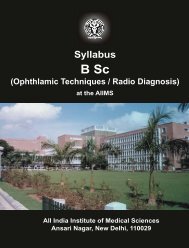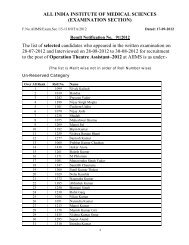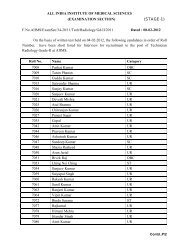Manual for long-term pharmacotherapy - All India Institute of Medical ...
Manual for long-term pharmacotherapy - All India Institute of Medical ...
Manual for long-term pharmacotherapy - All India Institute of Medical ...
Create successful ePaper yourself
Turn your PDF publications into a flip-book with our unique Google optimized e-Paper software.
Thus, a <strong>long</strong> acting drug like naltrexone is ideal <strong>for</strong> use in preventing relapse to opioid use.<br />
Evidence base<br />
Patients involved in meaningful relationships, employed full time, or attending school and living with family<br />
members are most likely to benefit from naltrexone treatment. Follow up <strong>of</strong> naltrexone treated patients<br />
indicates that 30-40% are opioid free <strong>for</strong> 6 months after <strong>term</strong>inating treatment.<br />
However, naltrexone treatment has a very high early dropout rate. Only 10-20% take naltrexone <strong>for</strong> 6 months<br />
or <strong>long</strong>er, although certain specific motivated populations like addicted pr<strong>of</strong>essionals and <strong>for</strong>mer prisoners<br />
on probation have significantly higher rates <strong>of</strong> accepting naltrexone and remaining in treatment. This may be<br />
due to the fact that naltrexone has no rein<strong>for</strong>cing properties <strong>of</strong> its own and is perceived as a subjectively neutral<br />
drug that prevents addicts from getting high. Kirchmayer and colleagues in 2002 systematically reviewed<br />
controlled clinical trials that there was insufficient evidence to justify naltrexone use in the maintainence <strong>of</strong><br />
addicts, except to decrease the possibility <strong>of</strong> reincarceration <strong>of</strong> prisoners treated with combined behaviour<br />
therapy and naltrexone. However a metanalysis <strong>of</strong> fifteen studies involving 1071 patients in 2006 found<br />
significant heterogeneity in the efficacy <strong>of</strong> naltrexone.The authors attributed this to the potential moderating<br />
effect <strong>of</strong> treatment retention This study concluded that retention was the key variable <strong>for</strong> understanding the<br />
mechanisms <strong>of</strong> the effect <strong>of</strong> naltrexone in opioid dependence and that the drug may be effective if the retention<br />
rate is increased above a certain level.<br />
Patient Selection<br />
Naltrexone therapy is suitable and recommended <strong>for</strong> patients with the following characteristics:<br />
�Younger persons at early stages <strong>of</strong> opiate dependence.<br />
�Persons currently abstinent but concerned about possible relapse and willing to be on a medication that<br />
does not produce a high.<br />
�Employed individuals and pr<strong>of</strong>essionals (healthcare workers, lawyers, pilots, business people) facing<br />
loss <strong>of</strong> employment or licensure due to opiate abuse.<br />
�Former opiate dependent persons who have been drug-free e.g., in a rehabilitation centre, therapeutic<br />
community, or prison and wishing to remain abstinent.<br />
�Opiate-dependent persons who prefer to try alternative <strong>pharmacotherapy</strong>, other than methadone or<br />
buprenorphine.<br />
�Individuals who have been drug-free but recently relapsed on opiates.<br />
Patients, as well as their support persons, need education on how naltrexone works and the critical<br />
importance <strong>of</strong> compliance with the dosing regimen. It is advisable to supervise the ingestion <strong>of</strong> naltrexone either<br />
from the treatment centre (by the nurse/pharmacist) or tell a family members like wife, parent to administer the<br />
medication.<br />
40

















